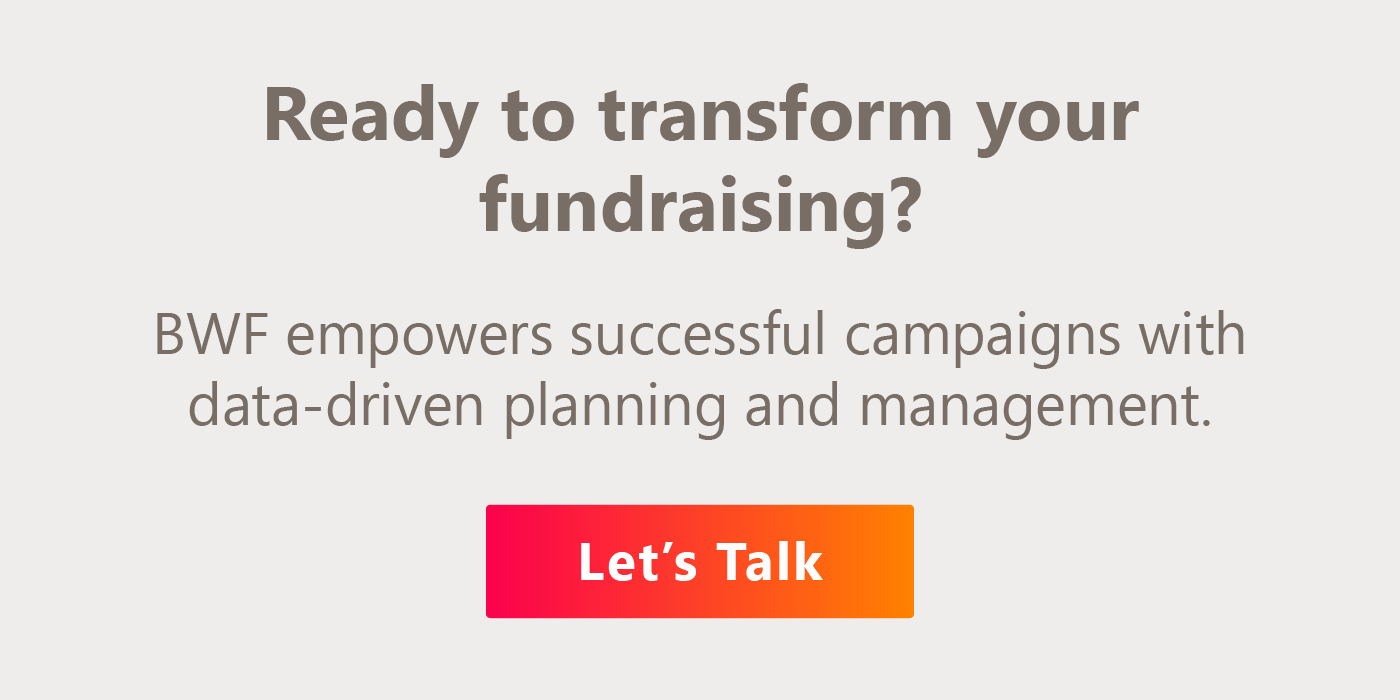As fundraising campaigns reach unprecedented heights (for example, philanthropic giving to higher education alone reached $59.5 billion in 2022), more organizations are launching major campaigns to raise more for their causes. If your organization is considering starting a large-scale campaign, you have two options: comprehensive campaigns and capital campaigns.
What is a comprehensive campaign, and how does it differ from a capital campaign? This guide will explore everything you need to know about these campaign types to determine which option best suits your goals. We’ll cover:
- What is a Comprehensive Campaign?
- What is a Capital Campaign?
- How to Choose the Right Campaign for Your Fundraising Goals
- Best Practices for a Successful Comprehensive Campaign
- BWF’s Approach to Comprehensive Campaigns
Launching a comprehensive or capital campaign can take your fundraising capacity to a new level. Each campaign you execute will build on the last, taking your organization on an upward trajectory and allowing you to make the most of your donor’s passion for your cause.
Let’s get started by defining what a comprehensive campaign involves.
What is a Comprehensive Campaign?
A comprehensive campaign is a major fundraising initiative an organization undertakes to raise funds for a broad range of needs. These campaigns encompass nearly all types of charitable gifts, including major gifts, planned gifts, grants, and restricted and unrestricted funds. They support a wide variety of projects including:
- Annual fund giving
- Capital projects
- Endowments
- Program development
- Operations support
Organizations that hold comprehensive campaigns include:
- Higher education institutions
- Healthcare organizations
- Cultural entities, like museums
- Nonprofits
- Religious organizations
Comprehensive campaigns generally follow the same phases as capital campaigns (explained in the next section) but have a broader focus.
For example, a capital campaign might focus on a project with a narrow scope, such as funding the creation of a new building at a university. On the other hand, a comprehensive campaign would target projects with a wider reach. This could encompass general improvements to university operations such as updating aging facilities, improving campus security, and supporting innovative research.
Because they have a broad scope, comprehensive campaigns are among the longest-lasting fundraising campaigns. They can last five to seven years and sometimes longer depending on your fundraising goal.
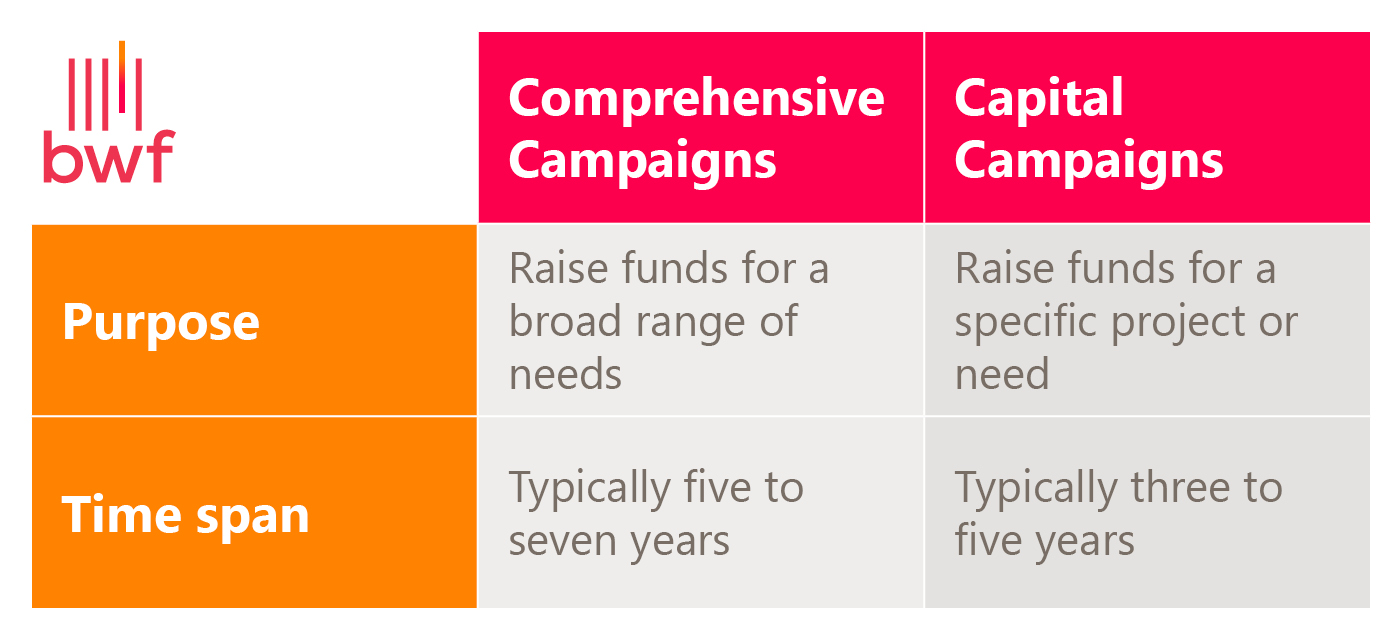
Pros and cons of comprehensive campaigns
| Pros | Cons |
| Offer flexibility to raise funds for a wide variety of needs | For organizations with a long history of comprehensive campaigns, these projects can begin to feel like an arms race with ever-increasing targets |
| Engage a community of partners such as clinicians, volunteers, donors, faculty, and leadership in your organization’s philanthropic work | May pull focus from other priorities, like operational funding |
| Nurture a culture of philanthropy that leads to sustained increases in giving | Can drain staff members’ time, especially for small fundraising teams |
| Identify the next generation of philanthropists by highlighting the myriad impacts of private support on your organization’s mission | May require complex coordination across multiple fundraising teams to stay on brand/message |
| Increase the organization’s level of sophistication leading to a more mature philanthropic enterprise | May make some donors feel that their gifts don’t matter |
What is a Capital Campaign?
A capital campaign is a targeted, time-bound fundraising effort to raise a large amount of money for a specific project. Organizations might launch capital campaigns to fund projects such as:
- Constructing a new building
- Acquiring land
- Starting a new program
- Making a major new equipment purchase
Capital campaigns have four primary phases:
- Planning phase and feasibility/campaign planning study. In the initial phase of a capital campaign, your organization will conduct research to determine whether you’re ready to take on a capital campaign and the likelihood of its success. Consider working with a consultant who can help you manage large-scale stakeholder surveys and campaign analyses. For example, BWF’s campaign planning services include interviewing top leaders and development staff, analyzing constituent data and past campaign performance, and interviewing donors and external stakeholders.
- Quiet/leadership phase. During a capital campaign’s quiet or leadership phase, you’ll solicit donations from major donors. You’ll raise most of your funding during this phase (around 50-75% of your total campaign revenue, based on your organization’s goals).
- Campaign kickoff. This stage is when you introduce your campaign to a wider audience of supporters and potential donors. You’ll promote your campaign with kickoff events and press releases to generate interest and excitement.
- Public phase. Throughout the public phase of a capital campaign, you’ll continue promoting your campaign to a broad audience to push toward your goal. Spread the word using marketing platforms like direct mail, social media, email, and your website’s blog. Your job is to maintain energy and enthusiasm to drive your campaign to the finish line.
After your capital campaign concludes, you’ll review your results and thank the donors and supporters who contributed to your success. Capital campaigns tend to have a shorter timeline than comprehensive campaigns—they may last around three to five years.
Pros and cons of capital campaigns
| Pros | Cons |
| The time-bound nature of a capital campaign can inspire urgency among donors | Risk of focusing heavily on one project and neglecting other priorities, like annual giving |
| Can focus your messaging around one single goal rather than a variety of initiatives | Not reaching the campaign goal could damage your organization’s reputation |
| Provide an opportunity to strengthen donor relationships through targeted, personalized asks | Potential for overreliance/attention paid to major donors at the expense of mid-level donor stewardship |
| Having a single focus can maintain momentum to drive campaign success | The shorter campaign timeline could become a drain on time and resources |
How to Choose the Right Campaign for Your Fundraising Goals
After reviewing the pros and cons of both campaign types, how can you determine what type of campaign will work best for your organization’s needs? Discuss these considerations with your fundraising team:
- Assess your needs and goals. What type of support would your organization benefit from most over the next several years—broad support for a range of needs or targeted support for a specific goal?
- Evaluate your current fundraising capacity and financial health. You’ll need a strong fundraising foundation, an experienced team, and effective fundraising software solutions for either campaign type. Does your organization enjoy a high employee retention and satisfaction rate? Are your stakeholders, like staff, volunteers, board members, and major donors, excited about the prospect of a major campaign? Are your tech solutions up-to-date and comprehensive?
- Understand your donors’ interests. Are your supporters more inclined to support broad initiatives that target long-term resilience, or do they like to fund projects with a single, tangible focus? How challenging will it be to get supporters on board with your campaign?
Ultimately, one campaign type isn’t “better” than another. It’s about what will work best for your organization’s needs, capacity, and goals. An experienced campaign planning consultant can assess your current foundation, choose the right campaign for your needs, and manage campaign preparation to set your initiative up for success.
Best Practices for a Successful Comprehensive Campaign
If you decide to move forward with a comprehensive campaign, you’ll need to devote your resources, time, and energy to pushing toward your goal. Keeping the following best practices in mind will increase your chances of success:
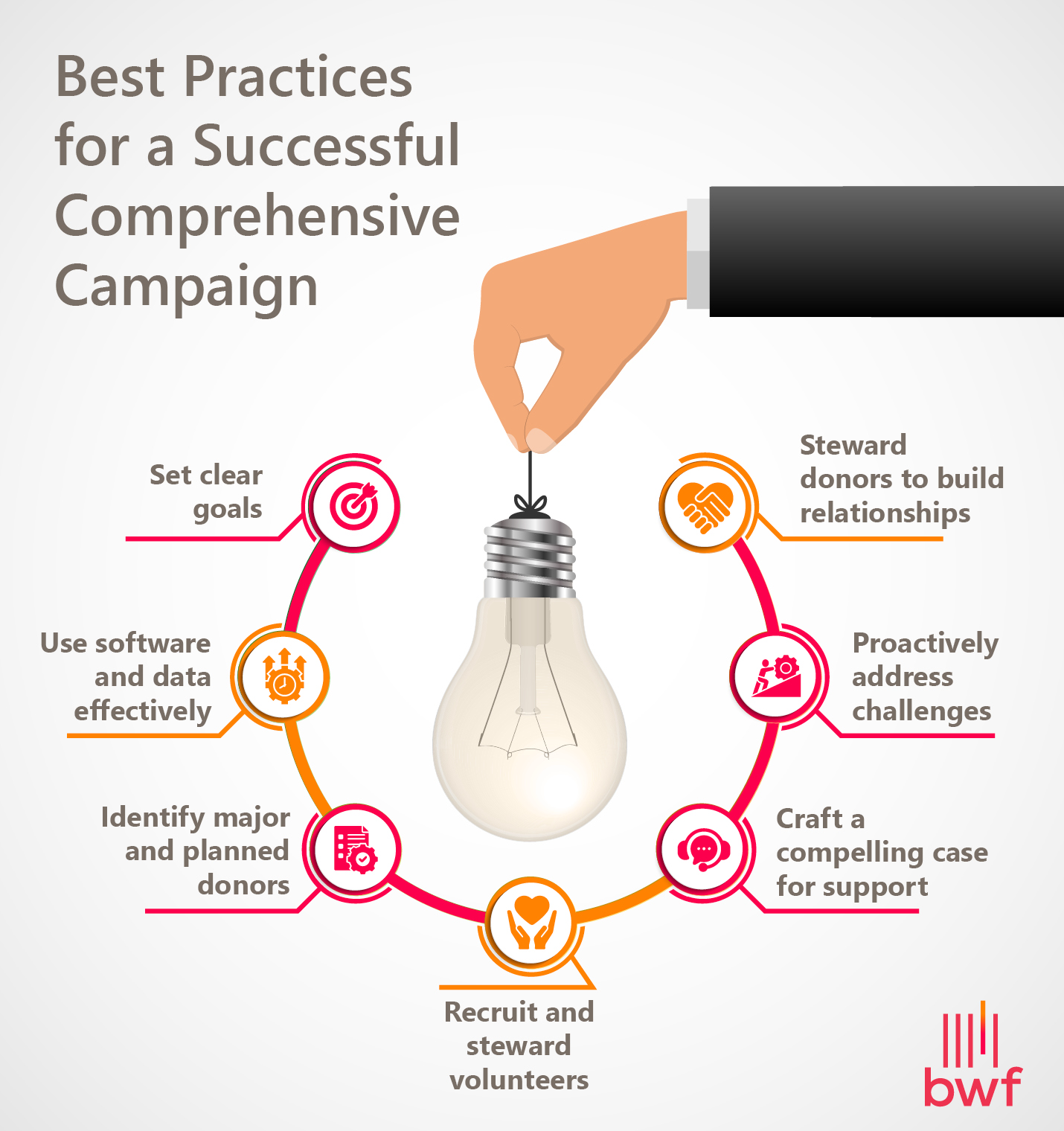
Set clear goals
Even though comprehensive campaigns target a wider range of needs, they still need clear goals. Establishing priorities and objectives for your campaign will help keep it on track and make it easier to explain the campaign’s purpose to your audience.
To set goals for your campaign, follow these steps:
- Identify your most essential short- and long-term fundraising needs.
- Rank these priorities in order of importance, urgency, and relevance to your mission.
- Select the top three to five priorities as your campaign objectives.
- Set a financial target based on the expected costs of achieving your goals. Consider selecting an ambitious goal to push your campaign to greater heights than any previous undertaking. This can motivate your team and donors to take your fundraising to a new level.
- Choose non-monetary objectives, such as new donor acquisition rates or donor retention-related targets. Having donor stewardship goals is essential to building positive supporter relationships that last long after your campaign concludes.
For example, Marquette University’s successful “Time to Rise” campaign had these four objectives:
- Enrich and expand student opportunities
- Support our teacher-scholars
- Foster university-wide innovation
- Transform our campus environment
Conduct a feasibility or campaign planning study to determine whether your goal is practical based on your current level of fundraising support. Use feedback and insights from the study to adjust your goals as needed. For example, based on your donors’ high giving capacity and excitement for the campaign, you might determine your campaign would be more successful if you set a slightly higher financial target.
Use your technology ecosystem to support your campaign
19% of respondents to our philanthropic campaigns survey said investing in their organization’s fundraising capacity was the largest success factor in their campaign. Building your technology stack is critical for growing your fundraising capabilities and managing large amounts of data.
In the planning phase of your campaign, review the following technology tools to ensure they’re serving your needs effectively:
- CRM technology. Is your current CRM the right tool for your needs, or would you be better off migrating to a new system? Are you making the most of all the features available in your CRM? Is your platform configured to your unique specifications?
- Fundraising predictive analytics and other AI fundraising tools. Are you using predictive models trained on your organization’s dataset? Do your AI solutions promote diversity and avoid perpetuating stereotypes? Do you need to create any new models to support your upcoming campaign?
- Marketing platforms. Are you using your audience’s preferred marketing channels to their fullest potential? Do you have a variety of tools at your disposal to automate the marketing process, such as an email marketing or social media scheduling platform?
Work with a technology professional like a CRM consultant to determine whether your solutions are working effectively to support your campaign. These professionals can audit your current systems, perform a needs assessment, recommend new CRM platforms, and manage implementation.
Identify major and planned donors
BWF’s research shows that around 30% of total annual attainment is contributed by just three top constituents. About 50% of attainment comes from the top 50 donors.
Plus, respondents to our campaign study noted that principal gifts are the most important campaign success factor. This underscores how vital it is to engage with major donors during your campaign.
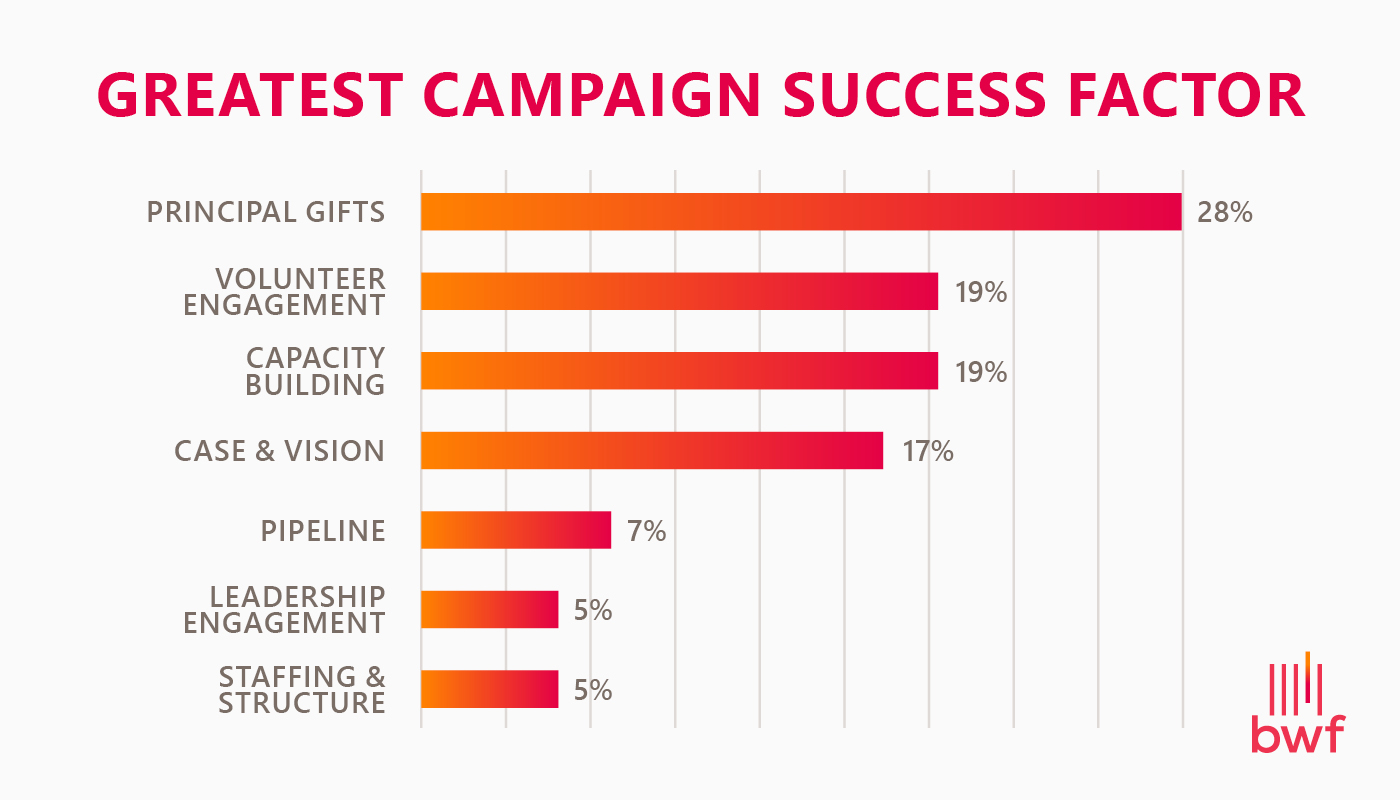
Use predictive modeling tools and strategies to pinpoint likely major gift prospects. These solutions leverage past campaign and donor data to identify prospects with a high giving capacity and a strong affinity for your cause. Top prospective major donors will exhibit characteristics such as:
- Past support of your nonprofit’s campaigns
- History of donating to similar initiatives
- Expressed desire to make a major impact or leave a legacy
- Wealth indicators including real estate ownership, stock holdings, and business affiliations
Create a gift range chart to identify how many donors you’ll need to secure at each giving level to reach your goal. Here’s an example of what your gift range chart could look like:
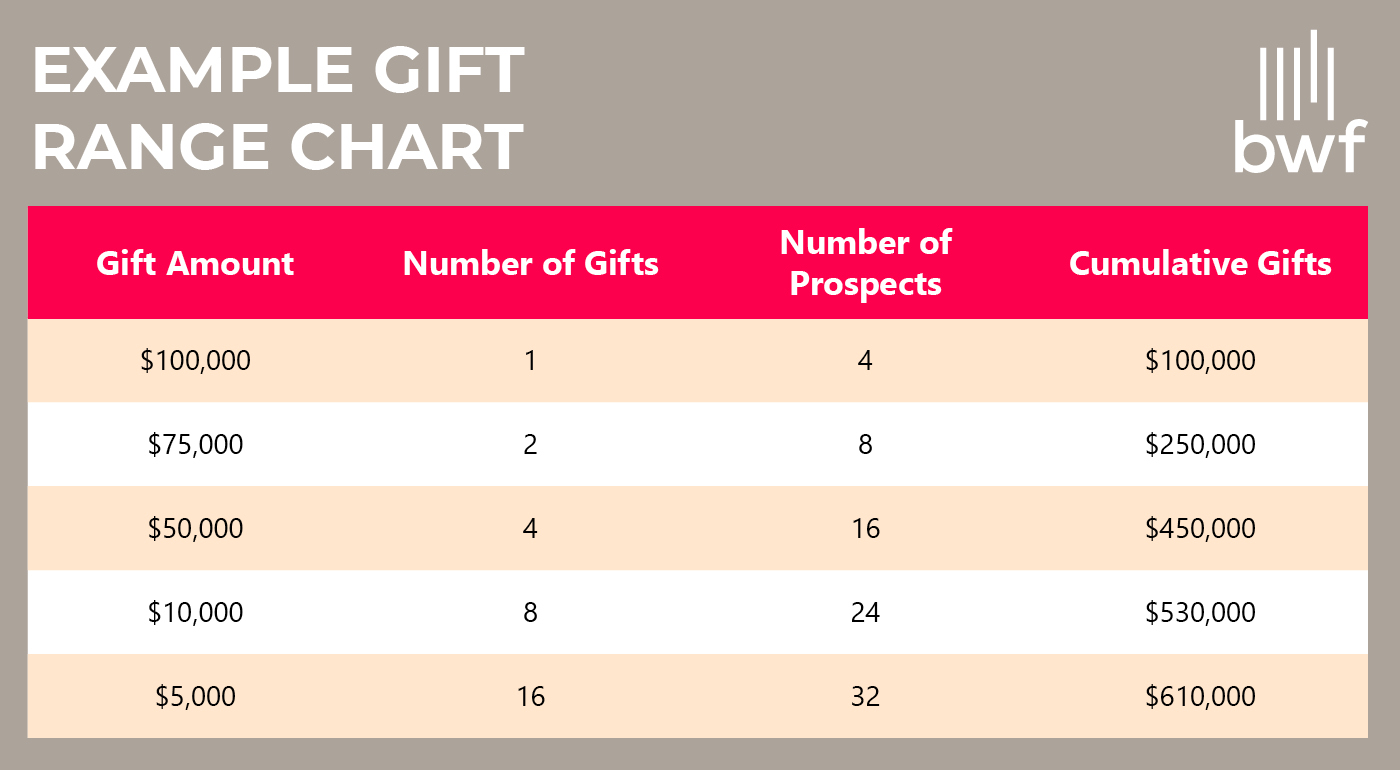
Use this basic format to tailor your chart to your unique campaign goals.
Recruit and steward volunteers
After principal giving, volunteer engagement was noted as the second most important factor for major campaign success. The majority of respondents to our campaign survey “strongly agree” that volunteers play an important role in their campaigns.
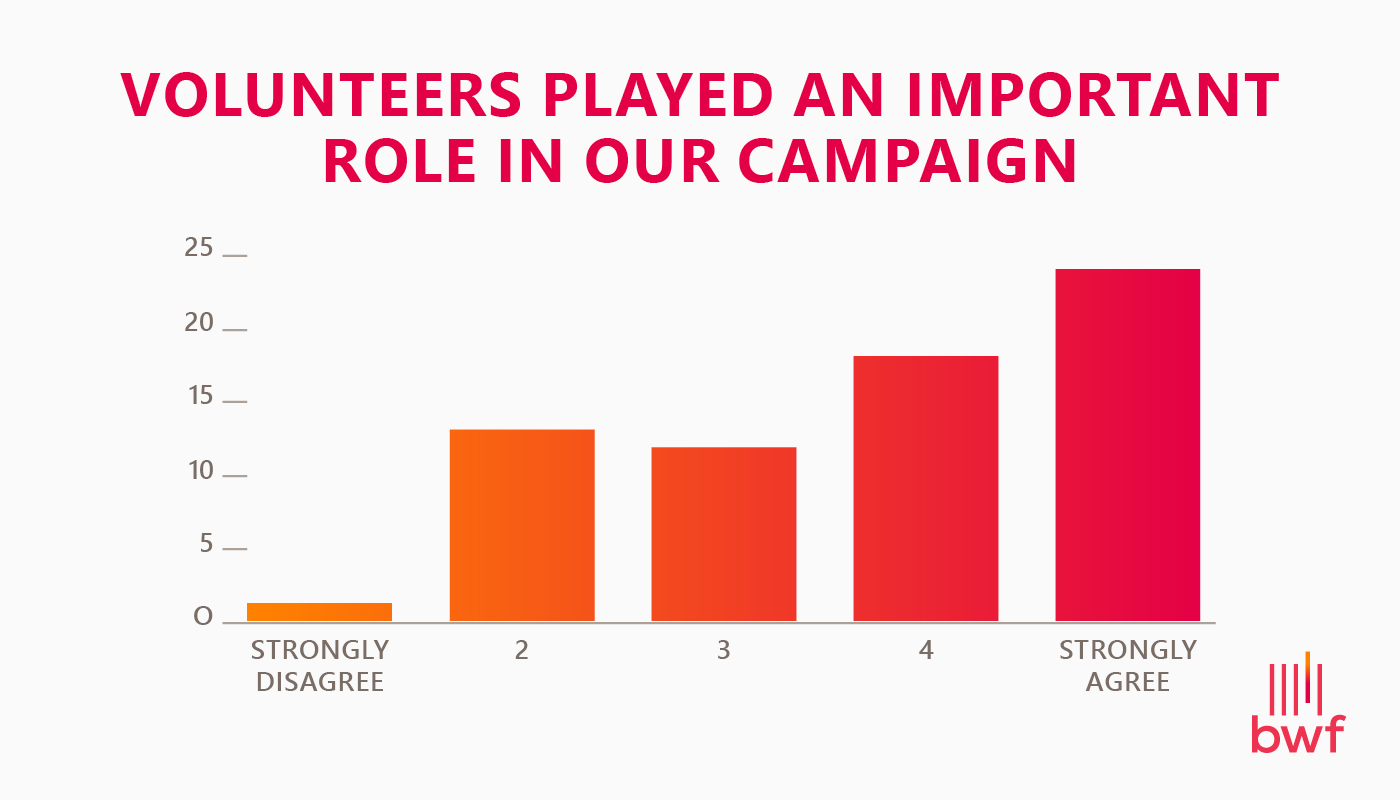
Volunteers help spread the word about your campaign and inspire engagement by sharing their authentic passion for your mission. A well-staffed volunteer committee will help drive your campaign and keep your initiatives on track. We recommend the following steps for finding the right volunteer leaders:
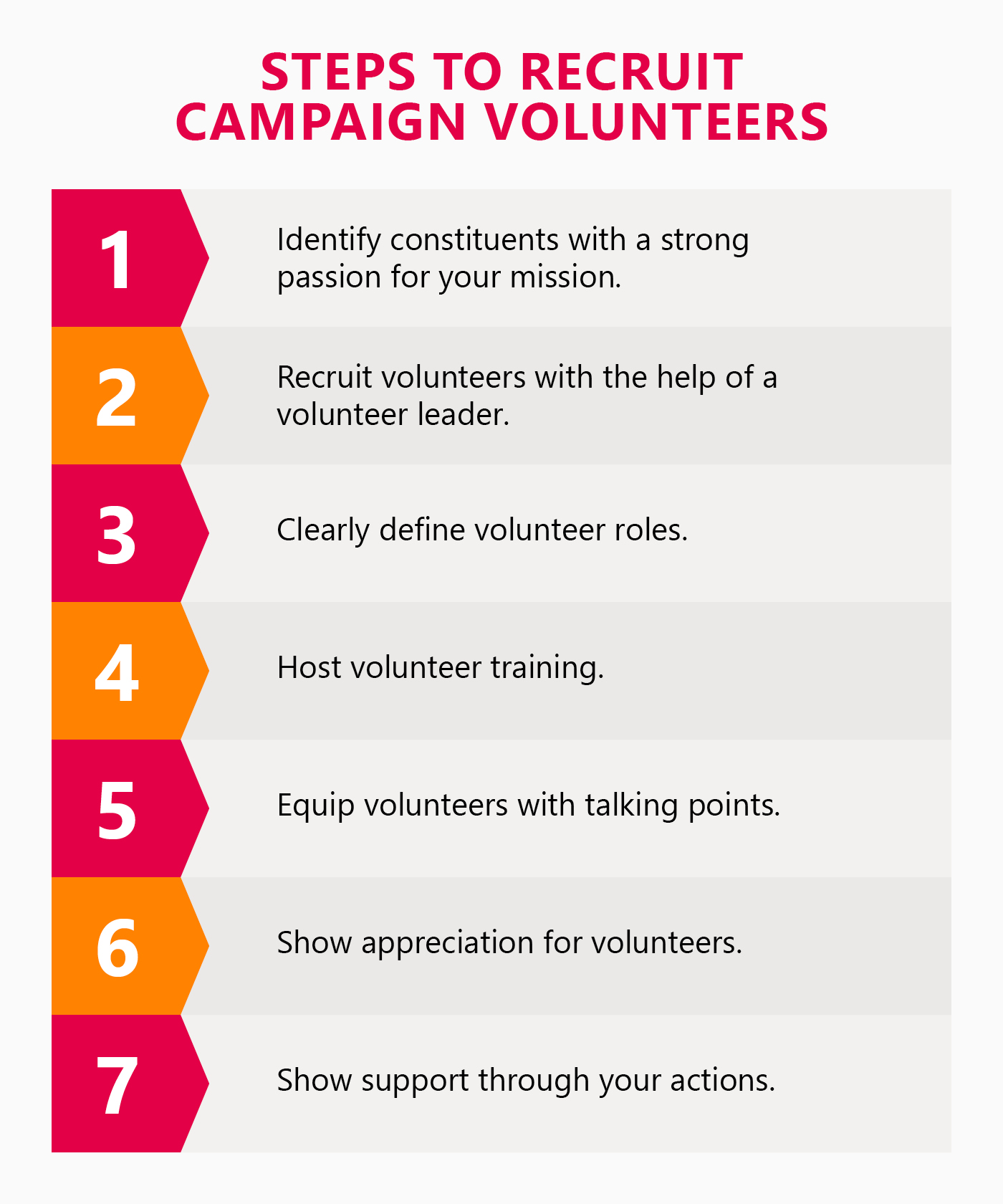
- Identify constituents with a strong passion for your mission. These individuals should feel excited about your campaign and its potential impact on your mission. They should be able to commit to the full campaign timespan. Volunteers should also have relevant skills, such as hosting campaign awareness events or sharing their personal connection to your mission in compelling ways.
- Recruit volunteers. Start recruiting volunteers in the early planning stages of your campaign to get their input from the very beginning and foster a greater sense of ownership. First, reach out to one individual who will act as your volunteer leader. This should be the most passionate, dedicated person in your potential volunteer pool. Once this volunteer is on board, you can use their help to recruit other members to your volunteer committee.
- Clearly define volunteer roles. Create a written job description to define the expectations of each volunteer role. If volunteers are also expected to contribute to the campaign, make that clear right away so there is no confusion.
- Host volunteer training. Get volunteers up to speed with an onboarding session. This could include weekly 15-minute check-ins or longer training sessions held over several days. Consider creating a mentor system to partner up new and experienced volunteers. This can help volunteers form personal relationships and learn from each other.
- Equip volunteers with talking points. Volunteers should be intimately familiar with your case for support, primary talking points, case studies, and other campaign promotional materials. Help volunteers practice their elevator pitch for speaking with major donors or corporate sponsors.
- Show appreciation for volunteers. Recognize the vital role volunteers play in your campaign by planning ongoing appreciation efforts. For example, during your bi-weekly volunteer committee meetings, plan a few minutes to spotlight volunteers who went above and beyond. You can also host regular volunteer appreciation social events, like happy hours or brunches, to allow volunteers to relax and keep their spirits high.
- Show support through your actions. In addition to telling volunteers how much you appreciate them, show them your gratitude through your actions. Volunteers should feel comfortable and supported in their roles throughout the campaign. Assign several staff members to act as go-to resources for volunteers. Support volunteers with the equipment, technology, and supplies needed to be successful.
If volunteers have a positive experience supporting your campaign, they’ll be much more enthusiastic about promoting your fundraising efforts. Plus, they’ll be more likely to help out the next time your organization launches a major fundraising initiative.
Craft a compelling case for support
BWF’s campaign survey found that 17% of organizations identified the case for support and vision for the organization as the top success factors for their campaigns.
Identify one overarching message that summarizes the campaign and speaks to the most urgent problem your organization is facing. Keep these words of advice from Carole Arwidson, the director of strategic communications at BWF, in mind as you choose your campaign’s message:
“The right big idea may not only pique the interest of individuals already in your pipeline but may very well attract those unfamiliar with your organization yet eager to solve that specific problem and keen to collaborate with someone to make it happen.”
Many organizations use guiding “pillars” or values to promote their case for support. Take a look at these examples to help generate ideas:
- Marquette University’s Time to Rise campaign was based on pillars of excellence, service, and faith.
- The University of Alabama’s Rising Tide campaign is centered around pillars of promise, prominence, pride, and passion.
- The University of North Dakota’s Forever UND campaign focused on key concepts like building for the future, inspiring leaders, empowering action, and leading for the future.
Once you have a clear idea of your campaign’s values, gather marketing collateral like images, videos, and infographics to bring your case for support to life. Branded informational videos in particular are easy ways to summarize your campaign, share clips of the people who will be supported by your campaign, and provide information about ways to donate.
Proactively address challenges
A comprehensive campaign, by nature, lasts a long time. Think about how much happened in the past five to seven years: the COVID-19 pandemic and the ensuing economic contraction, multiple pivotal political elections, and major global conflicts. All this is to say that your campaign will inevitably face unexpected roadblocks or setbacks, many of which are outside your control.
However, you can still create a plan for how your organization will respond when hurdles arise. For example, consider how you can respond to common campaign challenges such as:
- Economic downturns
- Team member burnout
- Competition from similar organizations
- New legislation that impacts data management and privacy regulations
- Staff or volunteer turnover
You can’t predict the future, but planning for a few common challenges will put you in a stronger position when issues arise. Better yet, planning ways to proactively address challenges can help stop problems before they pick up speed. For example, fight team burnout by celebrating smaller victories, showing appreciation for team members, and sharing stories that spotlight the positive impact your campaign is having.
Steward donors to build genuine relationships
For your organization to thrive even after your campaign concludes, you must steward and build relationships with campaign donors. Don’t treat their contributions as one-time gifts; think of them as stepping stones to continued engagement with your organization.
According to donor experience research, not receiving acknowledgment is one of the top reasons donors stop giving to organizations. In addition, a study called “Understanding How Donors Make Giving Decisions” from the Indiana University Lilly Family School of Philanthropy notes that “while researchers have long known that donors value information about the impact of their gifts, the new studies indicate that donors’ expectations of feedback about their gifts and the causes they support [are] increasing and becoming more sophisticated.”
With a forward-thinking stewardship approach that emphasizes impact, you can maintain donors’ support for the long term. Improve your donor experience by taking the following steps:
Personalize donor outreach
Provide personalized impact reports for major donors with charts and graphs showing the impact of their gifts on your fundraising goal. For mid-level and smaller donors, personalize your thank-you emails and letters with their names and specific donation amounts.
Include photos and videos that demonstrate the importance of their donations. For example, you could include photos of students enjoying your university’s campus, or patients receiving care at your hospital.
Foster community among donors
Invite donors to events held throughout your campaign. For example, you could invite donors to a behind-the-scenes tour of your facilities, a networking happy hour, or a meet-and-greet with your organization’s top leaders. Doing so helps donors feel like true partners in your campaign’s success.
Offer thank-you gifts
Strategically offer different types of gifts to donors based on their giving level.
For example, you could offer small donors tokens like complimentary merchandise or early event access. Mid-level donors could receive larger gifts such as gift baskets or invites to exclusive events. Major donors could receive your largest gifts, such as an engraved plaque or naming rights.
Offering different types of gifts helps demonstrate the appropriate level of appreciation for each gift.
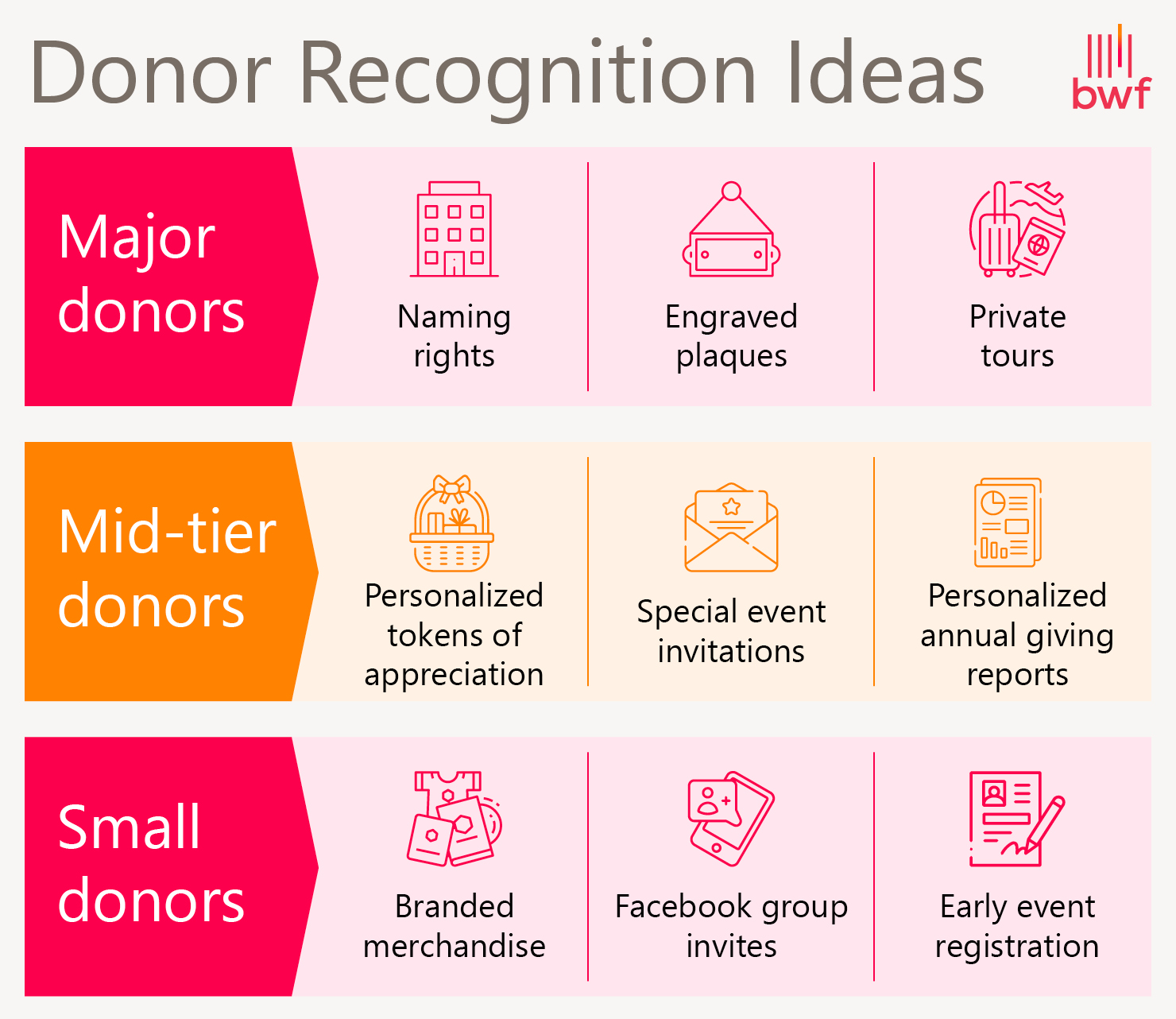
In addition, create a plan for post-campaign follow-up. Share fundraising results and keep donors informed about the progress you’re making with your new projects or initiatives. Emphasize the impact of these projects on your ability to achieve your mission.
For example, let’s say you’re raising funds to support your endowment fund for your children’s hospital. Make it clear to donors that when they support your campaign, they’re not just helping you raise money. They’re directly contributing to research that helps kids fight diseases like cancer.
Building emotional connections with your audience will help retain their support throughout your campaign and beyond.
BWF’s Approach to Comprehensive Campaigns
If you’re looking for an experienced comprehensive campaign consultant who can support your campaign at every phase, BWF is here to help. Our campaign planning services take your campaign into hyperdrive to grow fundraising beyond your expectations.
We see campaigns as tools to lift your organization to a new plateau, helping to raise enthusiasm in your community, increase your staff’s capabilities, and ultimately bring your organization to a new level where you can better serve your community.
Our campaign services include:
- Comprehensive campaign assessments to evaluate your readiness ahead of a major undertaking
- Fundraising strategic planning based on your goals, market position, and resources
- Campaign planning (feasibility) studies to survey stakeholders and assess past campaign performance before launching your next campaign
- Volunteer engagement to help recruit a strong, passionate volunteer team and train them effectively for their roles
- Innovative, flexible fundraising approaches to mitigate challenges and respond to changing circumstances
- Ongoing campaign management to assess progress and report on results
Most importantly, we help build urgency surrounding your campaign. We answer donors’ pivotal question: “Why should I give now?”
Using strategic communications, a motivational case for support, and data-driven fundraising efforts, we help NGOs, healthcare organizations, and universities build urgency and excitement for their major campaigns.
Comprehensive campaign case studies
We work with organizations of all sizes to launch successful, data-driven comprehensive campaigns. To see how, explore a few of our case studies, including:
- University of Alabama: This university used our campaign planning services to conduct a readiness assessment and feasibility study. Ultimately, the study found that the University of Alabama could set an even larger campaign goal than originally anticipated.
- University of North Dakota: We worked closely with the University of North Dakota to provide ongoing campaign council, helping to elevate the focus on principal gifts, extend the university’s reach to new donor audiences, and train and support their leadership. As a result, they were able to elevate their fundraising to have record-setting years.
- St. Petersburg College Foundation, Inc.: This college needed strategic communications support to bring its first-ever comprehensive campaign to life. We helped develop core messages and identify the right platforms to connect with their audience.
- Whitman College: Through a multi-year partnership, we’ve helped Whitman College optimize its technology, improve efficiency, and engage alumni donors. These efforts culminated in launching the largest campaign in the university’s history.
Learn more about BWF’s approach to campaign planning and capacity building in this video:
Wrapping Up
As you can see, there are many benefits to comprehensive campaigns. However, they’ll require significant effort, team coordination, and community engagement. Whether you decide to host a comprehensive or capital campaign, don’t hesitate to reach out to an experienced campaign consultant who can help drive your effort to success.
Looking for more information to help host a successful campaign? Start with these additional free resources:
- 8 Steps to Create a Powerful Annual Giving Campaign. Want to focus specifically on building up your annual fund? Use the tips in this guide to create a powerful annual giving campaign.
- Digital Fundraising | 7 Powerful Campaign Ideas to Try. Much of your comprehensive campaign fundraising will take place online. This guide explores digital fundraising tips and ideas to get you started.
- Campaigns and Fundraising Strategy – BWF. Learn about BWF’s campaigns and fundraising strategy services, including campaign communications, prospecting, and more.
Let’s Talk
Find out how BWF can partner with you to launch your comprehensive campaign strategy.



